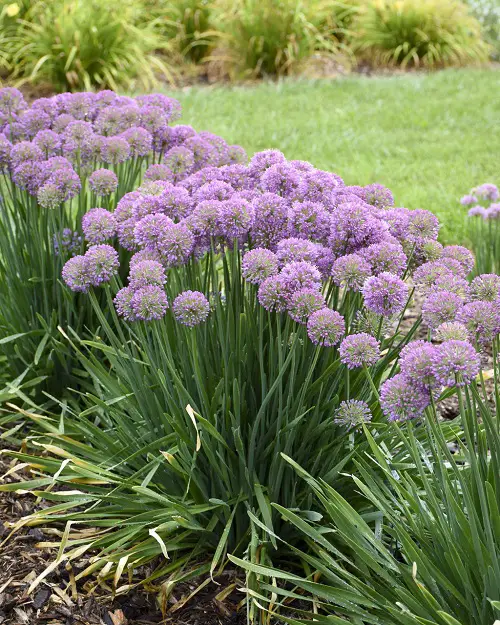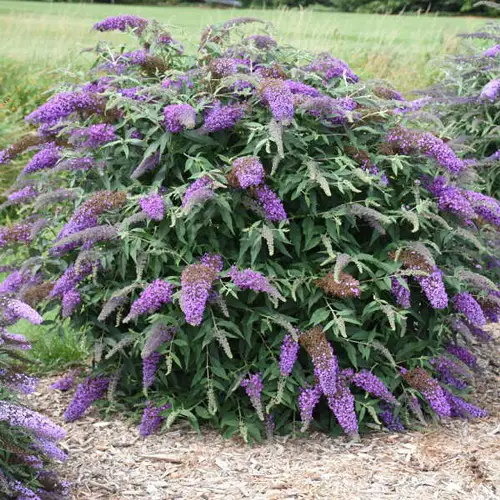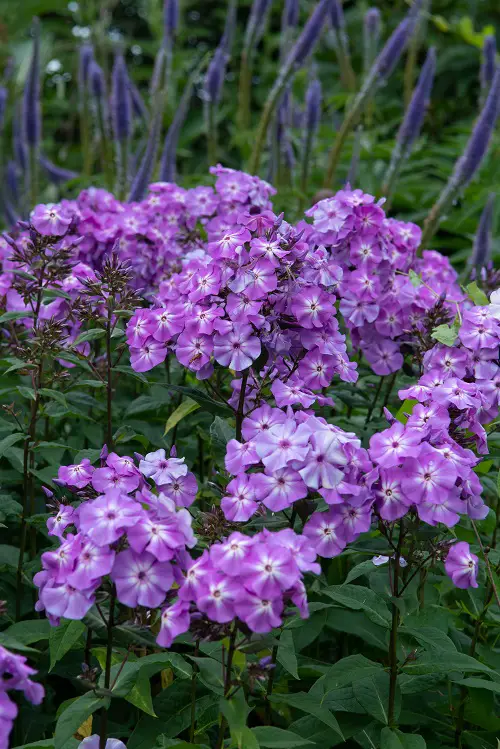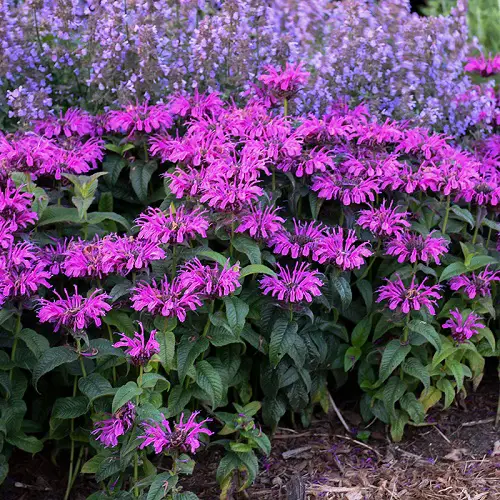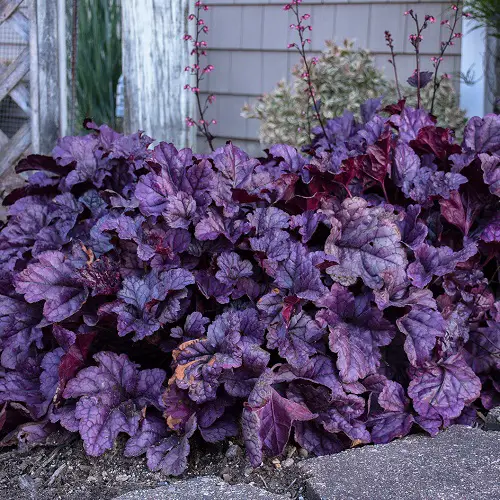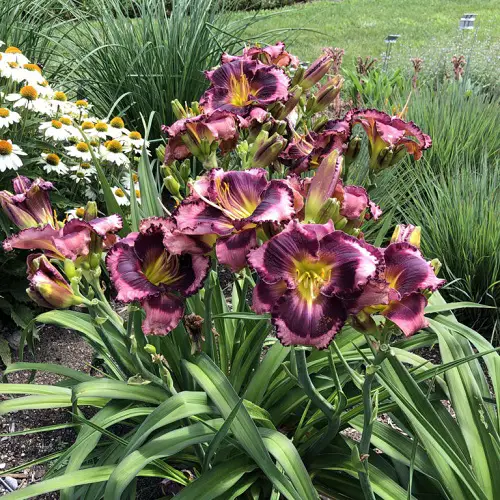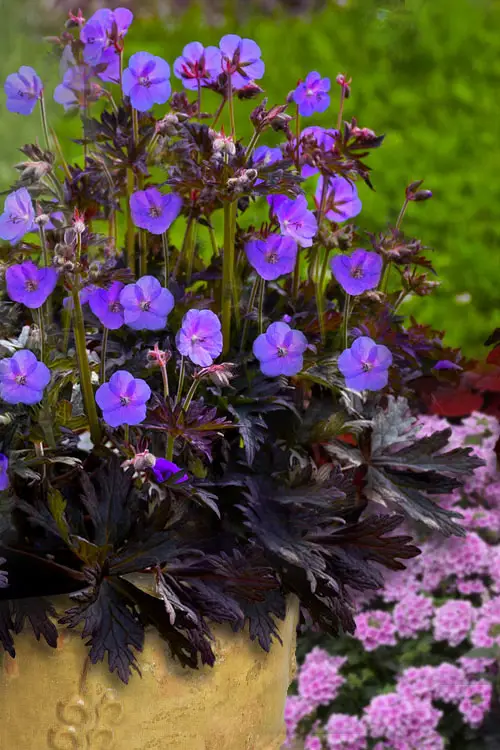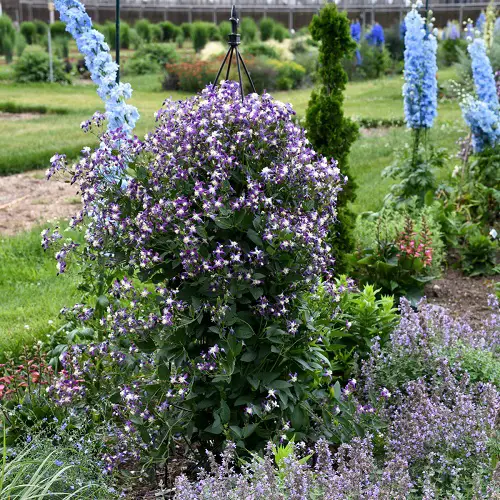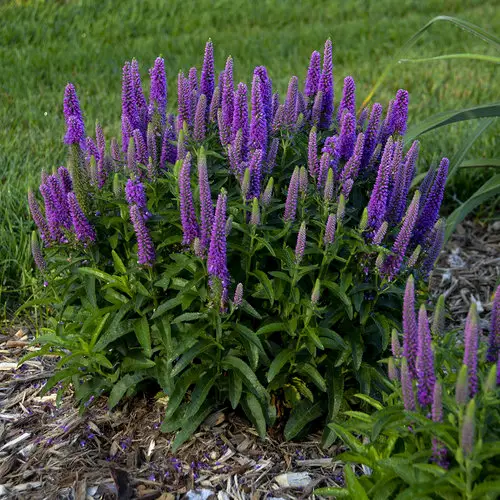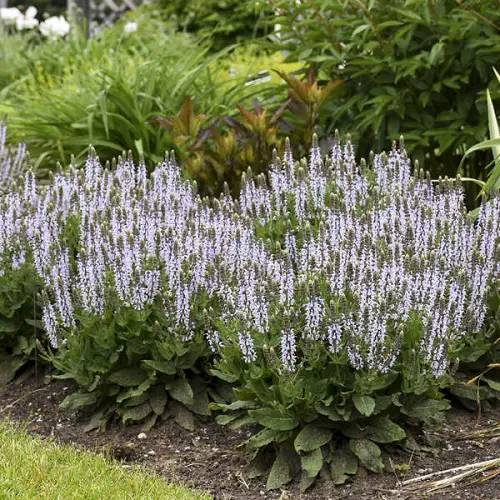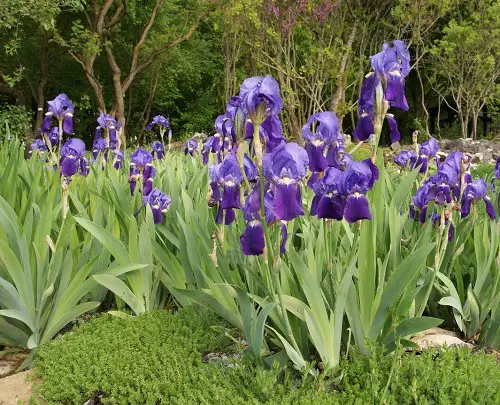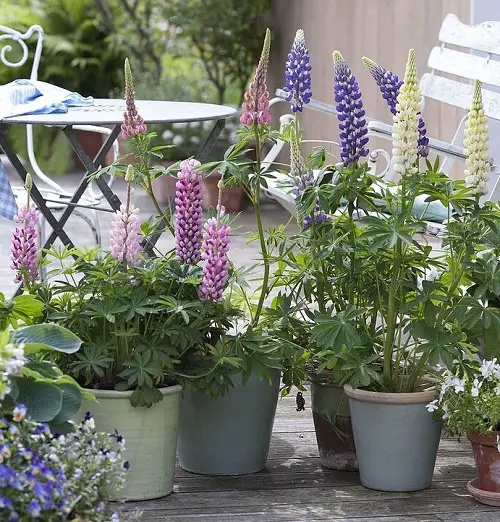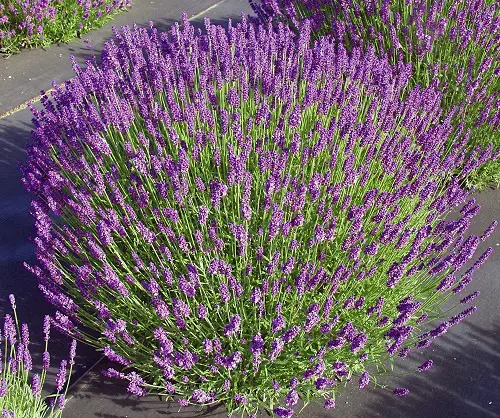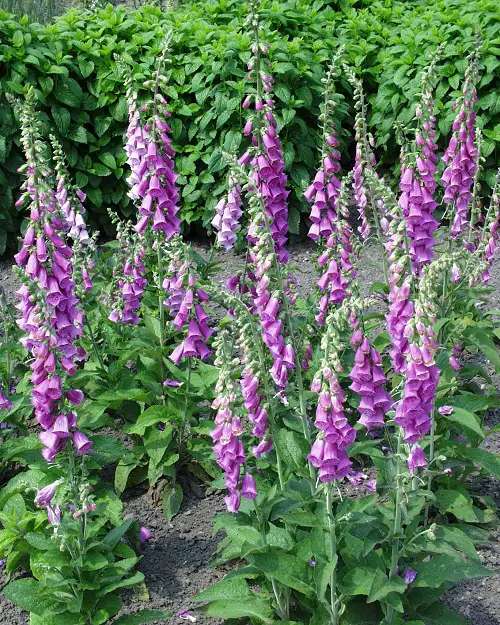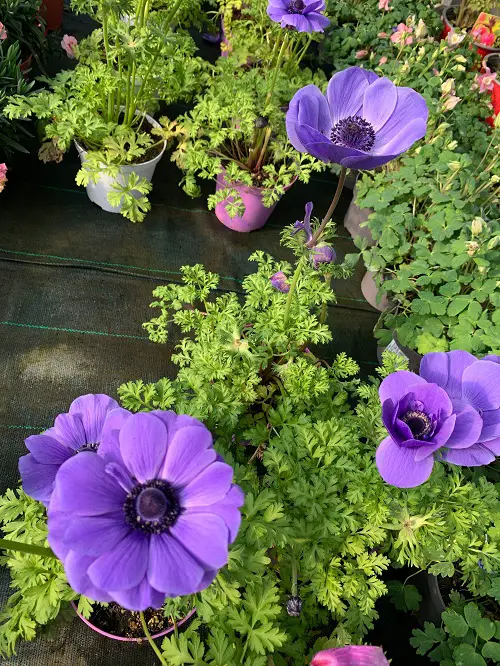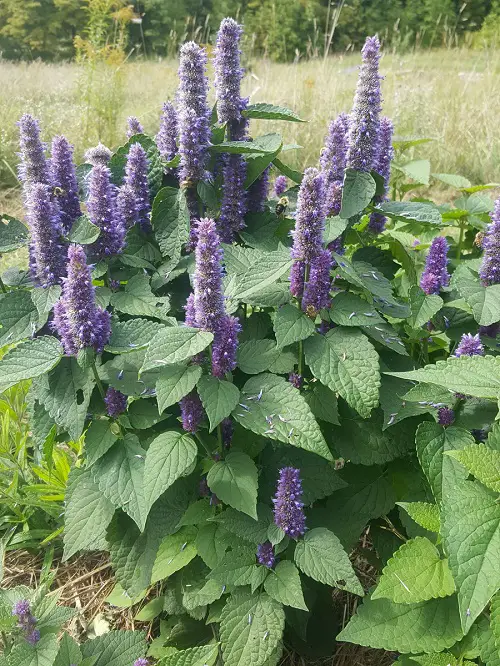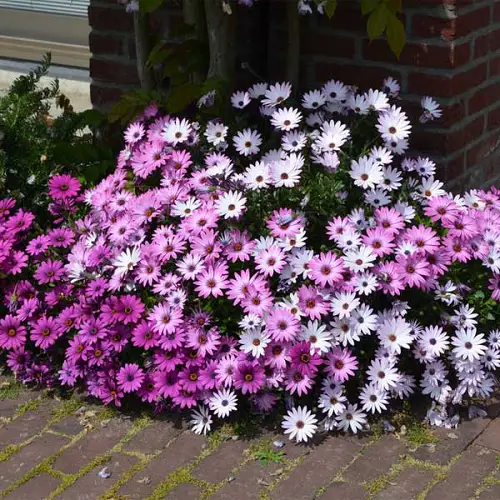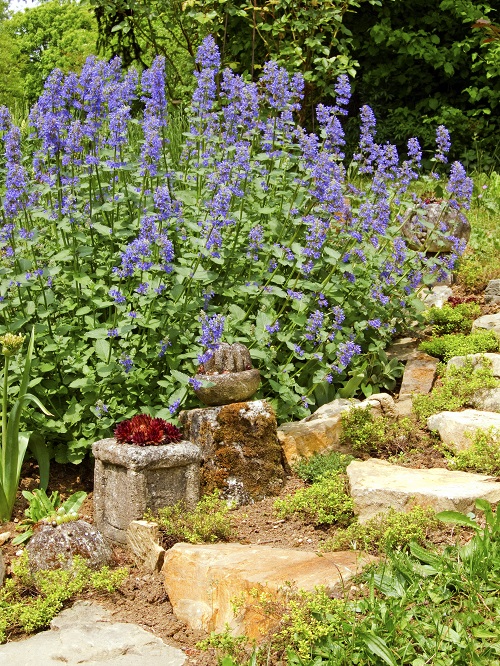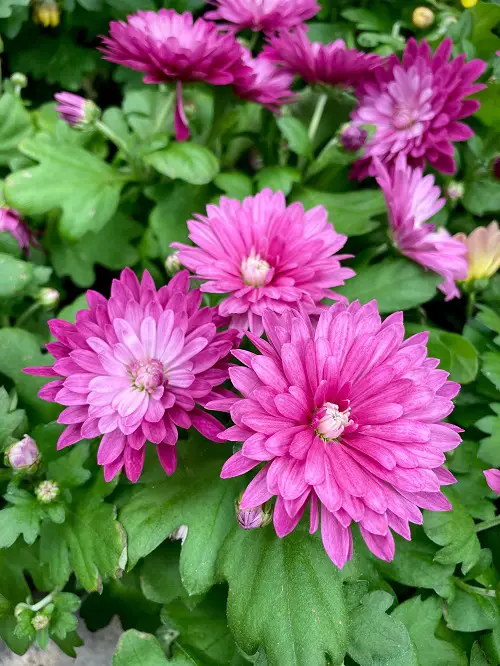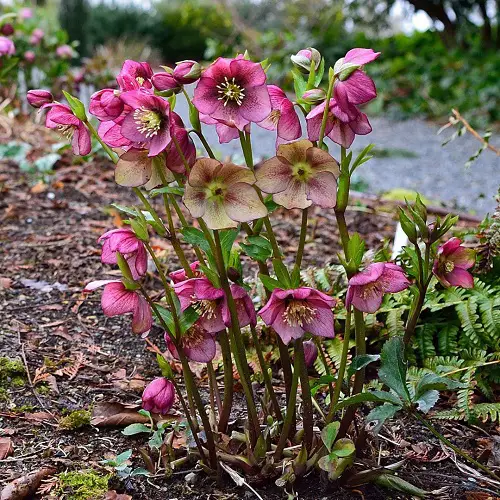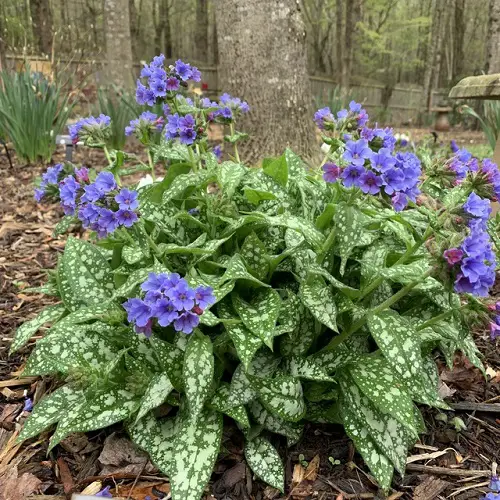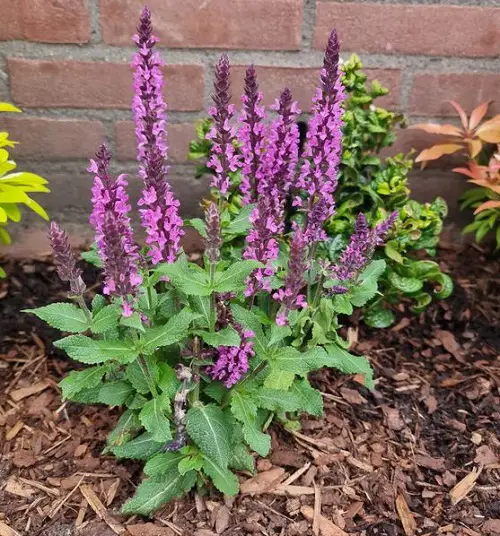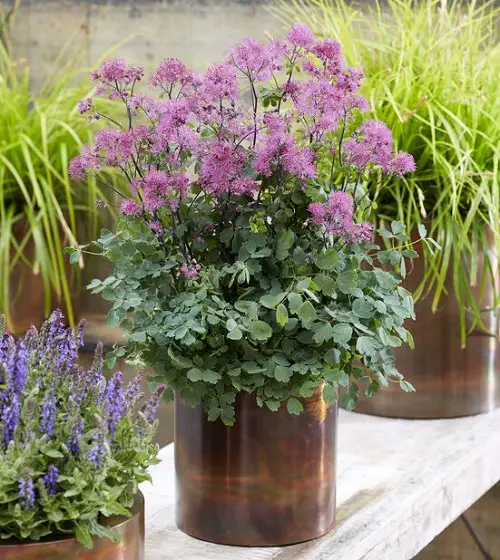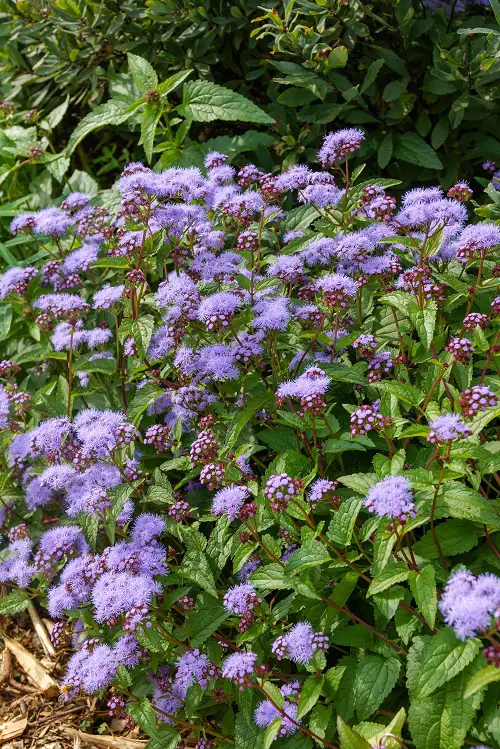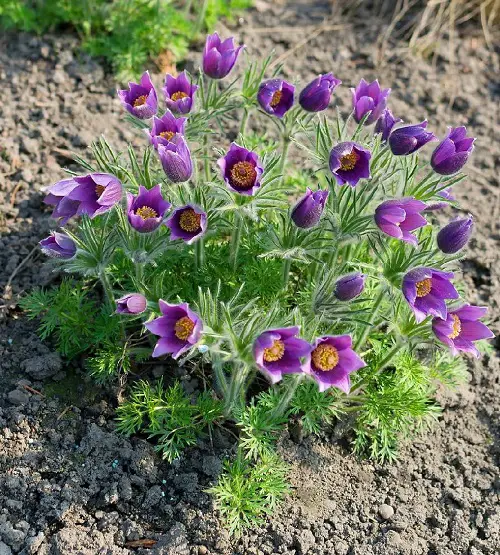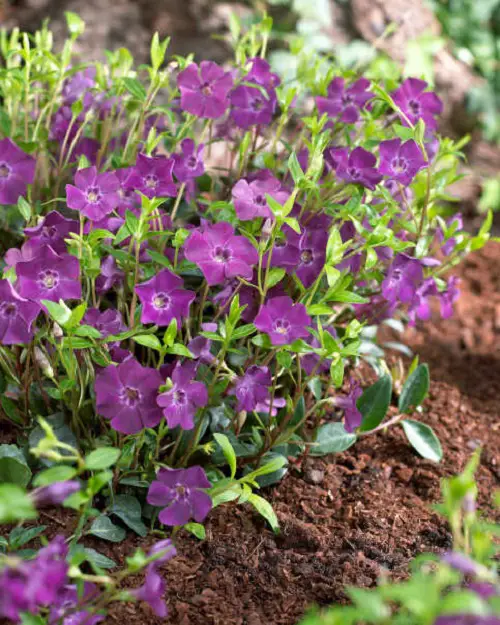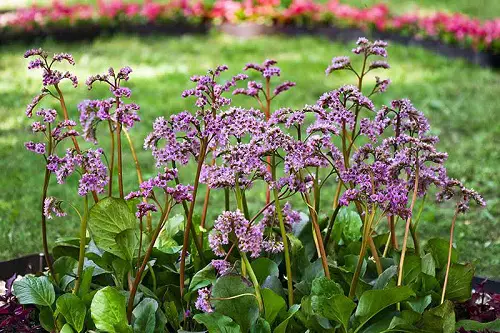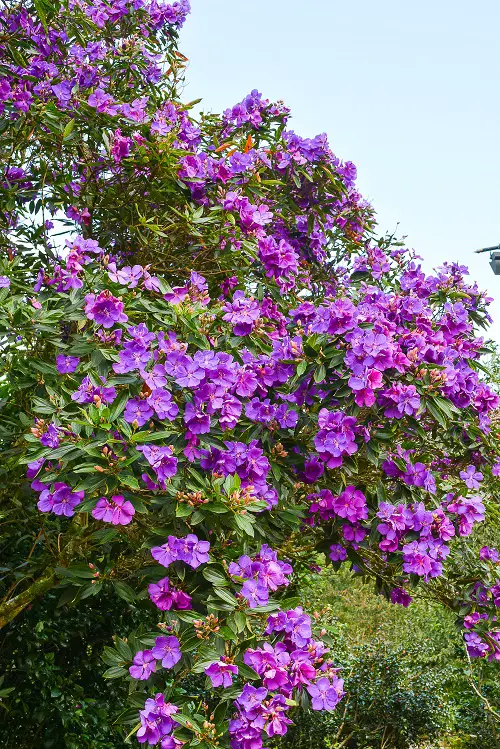Looking for the Best Purple Perennial Flowers for your garden? Then, look at this comprehensive list with beautiful options.
Purple Perennial Flowers are a favorite of many gardeners. They bring a touch of elegance and charm to any outdoor space. These pretty blooms are available in a wide variety of species.
Check out 11 Stunning White Flowers with Purple Center
Purple Perennial Flowers
(Do note that some of the flowers on this list may have a hint of blue or lilac hues in their color.)
1. Serendipity Allium
Botanical Name: ‘Serendipity’ Allium
USDA Zones: 4-8
These flowers offer globe-like, rosy-purple blooms that appear during mid-to-late summer. They release an exceptional onion smell when crushed.
2. Violet Dusk Baptisia
Botanical Name: Baptisia ‘Violet Dusk’
USDA Zones: 4-9
Baptisia ‘Violet Dusk’ displays lavender violet blooms with a cream base on a distinct vase-like growth habit. It does best in well-draining soil.
3. Grand Cascade Buddleia
Botanical Name: Buddleia ‘Grand Cascade’
USDA Zones: 5-10
The exquisite cascading light lavender-purple flower panicles of this Buddleia look beautiful over green leaves. Make sure it gets plenty of bright light.
4. Ultraviolet Phlox
Botanical Name: Phlox paniculata ‘Ultraviolet’
USDA Zones: 3-8
It features clusters of very dark, magenta-violet flowers that bloom above bright green leaves. This variety is more disease-resistant than common phlox.
5. Rockin’ Raspberry Monarda
Botanical Name: Monarda ‘Rockin Raspberry’
USDA Zones: 4-8
It grows vigorously and forms bushy, compact clumps of attractive, aromatic, deep green, glossy foliage and dark purple flowers.
6. Leading Lady Plum Monarda
Botanical Name: Monarda ‘Leading Lady Plum’
USDA Zones: 4-8
Monarda ‘Leading Lady Plum’ has a compact and early flowering habit. It features bright magenta-purple flowers with dark purple spots on the petals.
7. Wildberry Heuchera
Botanical Name: Heuchera ‘Wildberry’
USDA Zones: 4-9
It boasts large scalloped leaves in a shiny, eye-catching purple shade. The leaves feature a more intense pigmentation and keep their bold color for a prolonged period.
8. Storm Shelter Hemerocallis
Botanical Name: Hemerocallis ‘Storm Shelter’
USDA Zones: 3-9
This tetraploid daylily offers mauve-colored flowers that showcase enormous eggplant-purple eyes and matching pie crust edges.
9. Boom Chocolatta Gernaium
Botanical Name: Geranium pratense ‘Boom Chocolatta’
USDA Zones: 4-8
‘Boom Chocolatta’ is a Geranium pratense hybrid with amazing, dark bronze leaves and a tall, upright growth habit. The plant produces a plethora of blue-purple flowers.
10. Violet Stardust Clematis
Botanical Name: Clematis ‘Violet Stardust’
USDA Zones: 3-7
The plant showcases broad leaves and tiny, star-shaped, violet-blue flowers consist of four to five petals.
11. Lavender Bubbles Allium
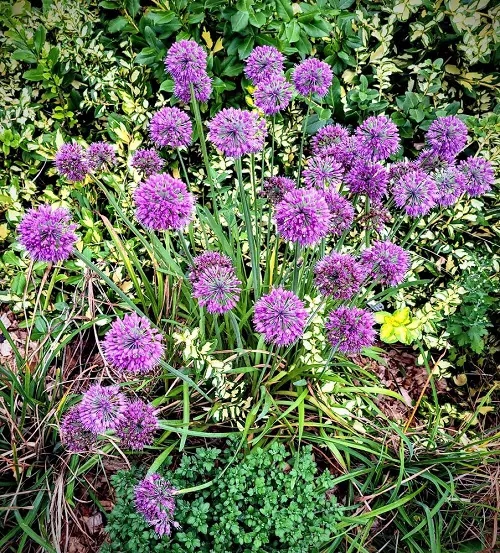
Botanical Name: Allium ‘Lavender Bubbles’
USDA Zones: 4-8
This plant produces mesmerizing dark, dusty purple flower globes that sit atop attractive glaucous blue-green foliage. The leaves have twists and curls.
12. Purple Illusion Veronica
Botanical Name: Veronica ‘Purple Illusion’
USDA Zones: 4-8
‘Purple Illusion’ produces rosy purple flowers with dark green leaves that form a dense canopy even after blooming.
13. Bumblesky Salvia
Botanical Name: Salvia nemorosa ‘Bumblesky’
USDA Zones: 3-8
This Perennial Salvia shows off vivid violet-blue color on denser, well-branched plants and neater upright flowering stems in containers.
14. Purple Sprite Phlox
Botanical Name: Phlox ‘Purple Sprite’
USDA Zones: 3-8
This interspecific Phlox offers a low, mounding habit of star-shaped purple flowers. As long as it gets bright, indirect light, it will continue to bloom!
15. Bearded Iris
Botanical Name: Iris germanica
USDA Zones: 3-10
German bearded iris offers a diverse range of colors, but the alluring hue of violet remains a popular choice for many gardeners!
Check 17 Stunning Succulents with Purple Flowers
16. Pacific Bleeding Heart
Botanical Name: Dicentra formosa
USDA Zones: 3-9
This herbaceous perennial produces lush, heart-shaped flowers with six rose-purple petals, with the outer two petals reflexed like spurs.
17. Purple Swirl Lupine
Botanical Name: Lupinus ‘Purple Swirl’
USDA Zones: 4-8
It features densely packed, sweetly scented flowers in a striped pattern of mauve and white. The blooms open gradually from the bottom, providing a long period of flowering.
18. Lavender
Botanical Name: Lavandula
USDA Zones: 5-10
Lavender is a fragrant perennial herb with spikes of small, purple-blue flowers and silvery-green foliage. It is a versatile plant that can be used in a variety of ways.
19. Monkshood

Botanical Name: Aconitum
USDA Zones: 3-8
Monkshood is a dramatic perennial plant with tall spikes of deep-purple blue, hooded flowers that add height and structure to the garden.
20. Foxglove
Botanical Name: Digitalis
USDA Zones: 4-9
A tall, stately plant with tubular flowers in shades of purple, pink, and white that bloom in early summer.
21. Purple Anemone
Botanical Name: Anemone coronaria ‘Blue Poppy’
USDA Zones: 7-10
It offers violet-blue satin, poppy-like blooms with a dark center; the blooms appear in mid to late spring.
22. Vivid Violet Scabiosa
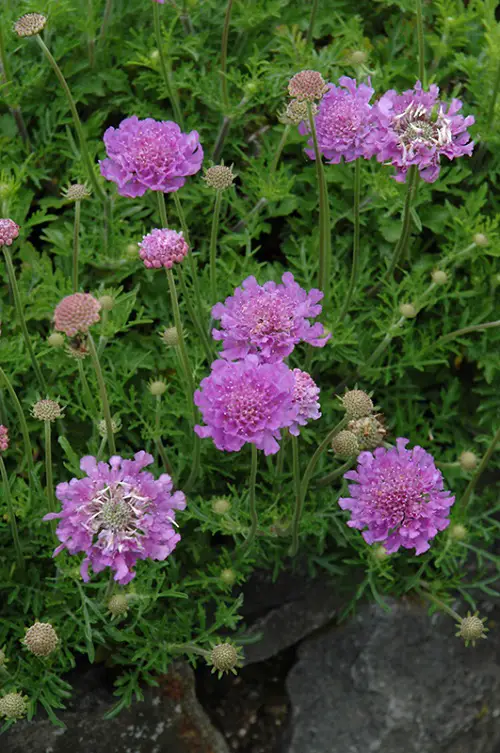
Botanical Name: Scabiosa ‘Vivid Violet’
USDA Zones: 6-9
Commonly called Pincushion Flower, is a compact and clump-forming perennial that forms a low mound of pretty purple blooms.
23. Anise Hyssop
Botanical Name: Agastache foeniculum
USDA Zones: 4-8
This fragrant plant has bluish-purple flowers and is a perennial herbaceous species. Its scent is often compared to that of tarragon or licorice.
24. African Daisy
Botanical Name: Osteospermum
USDA Zones: 8-11
African Daisies bear lavish lavender blooms. These magnificent flowers display a subtle blend of white, pink, or peach hues within their petals.
25. Catnip
Botanical Name: Nepeta
USDA Zones: 4-8
This purple perennial flower is highly resistant to pests and deer, and it is easy to cultivate. It is a fast-growing, low-lying perennial that can thrive in a wide range of conditions.
26. Chrysanthemums
Botanical Name: Chrysanthemums
USDA Zones: 5-9
Also known as mums, these plants offer clusters of flowers in purple shade. For best blooms, make sure it gets plenty of bright and indirect light all day long.
27. False Aster
Botanical Name: Boltonia
USDA Zones: 4-9
False Aster, as its name suggests, bears a striking resemblance to Aster flowers despite being a distinct species. It displays soft purple flowers in a bunch.
29. Jacob’s Ladder
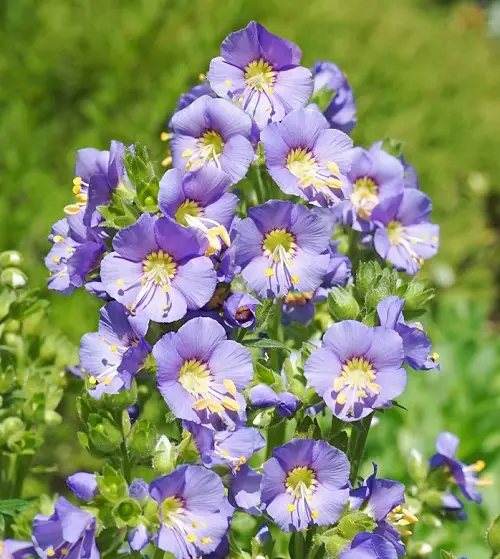
Botanical Name: Polemonium caeruleum
USDA Zones: 4-9
A wildflower that blooms only during the spring, its striking blue or purple hues are accentuated by a lively yellow dot at the center of each bloom.
30. Hardy Geranium
Botanical Name: Geranium bohemicum
USDA Zones: 3-9
Hardy Geraniums can display a range of colors, including blue, pink, white, and purple. Their delicate, cup-shaped flowers are a favorite of butterflies and bees.
31. Hydrangeas

Botanical Name: Hydrangea
USDA Zones: 3-7
These stunning flowers display an array of colors, including various shades of purple. The appearance of the foliage and flowers differs between each species.
32. Lenten Rose
Botanical Name: Helleborus orientalis
USDA Zones: 4-9
This perennial is relatively low-maintenance and develops exquisite flower buds that closely resemble roses. Its evergreen foliage and rosy-purple blooms give it a distinct charm.
33. Lungwort
Botanical Name: Pulmonaria
USDA Zones: 3 to 8
Lungwort is a petite plant that earned its name from its leaves, which resemble lungs. This plant has a slightly pink hue that later develops into striking violet-blue blooms.
34. May Night Sage
Botanical Name: Salvia sylvestris
USDA Zones: 4-8
May Night Sage showcases luscious purple flowers that blossom in late spring and reappear in the summer. It grows best in well-draining soil.
35. Meadow Rue
Botanical Name: Thalictrum
USDA Zones: 5 to 8
The Meadow Rue plant bears delicate clusters of light purple flowers with pale yellow pistils. The foliage of this perennial plant varies in color from blueish-green to yellowish-green.
36. Mistflower
Botanical Name: Conoclinium coelestinum
USDA Zones:5-9
Also known as Hardy Ageratum, it is a perennial plant that is characterized by its fuzzy purple flower clusters. The plant’s long stamens give it a misty appearance.
37. Pasque Flower
Botanical Name: Pulsatilla
USDA Zones: 4-8
Pasque Flowers come in a variety of vibrant colors, ranging from blue-purple to red-purple, depending on the species.
38. Periwinkle
Botanical Name: Vinca minor
USDA Zones: 4-9
Periwinkle is loved by many gardeners due to its small yet charming flowers that come in shades of blue, purple, lavender, and white.
39. Pigsqueak
Botanical Name: Bergenia purpurascens
USDA Zones: 4-8
The plant gets its name from the sound produced by the leaves when rubbed together, resembling the noise made by pigs.
40. Princess Flower
Botanical Name: Tibouchina urvilleana
USDA Zones: 9-11
The Royal Horticultural Society has bestowed the Award of Garden Merit to the Princess Flower, which produces splendid large purple flowers with striking magenta-colored buds.
41. Purple Bird Corydalis
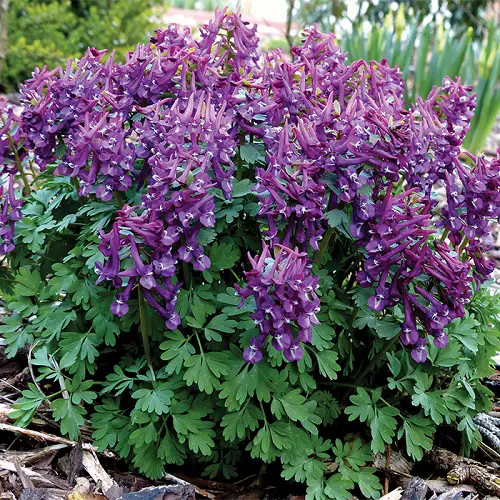
Botanical Name: Corydalis Canadensis
USDA Zones: 5-7
With its charming tubular flowers that resemble the shape of a crested lark, the Purple Bird Corydalis owes its name to the Greek origin of the term.
42. Russian Sage
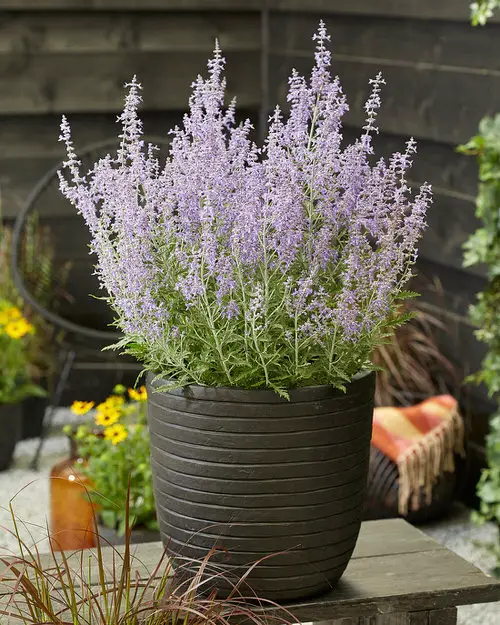
Botanical Name: Perovskia atriplicifolia
USDA Zones: 5-9
Boasting fuzzy cloud-like flowers that provide a unique texture to your garden, Russian Sage is a plant that is both visually appealing and aromatic.


